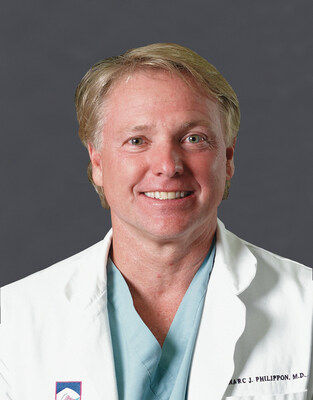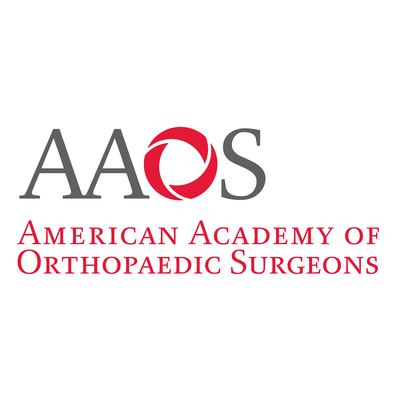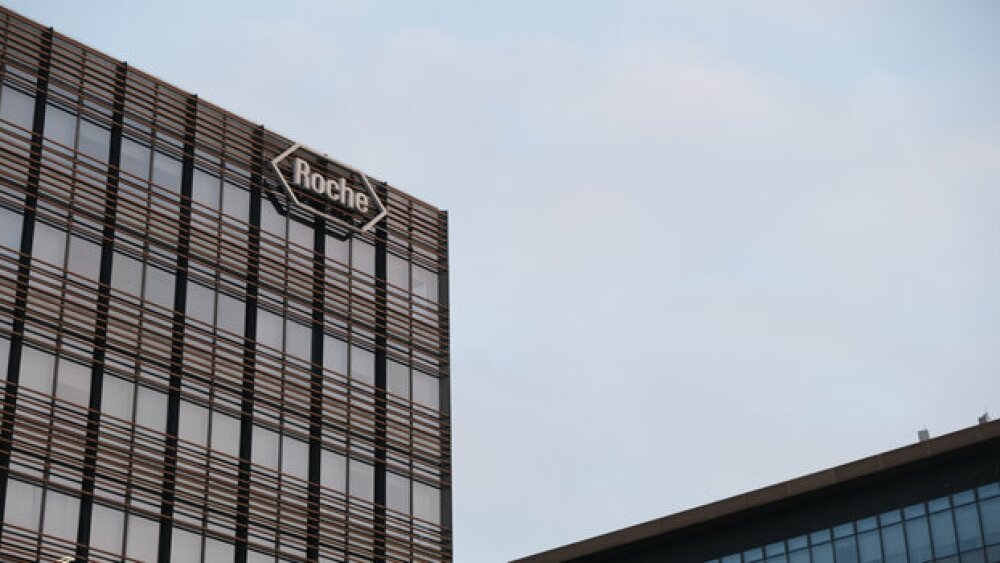Marc J. Philippon, MD, FAAOS, was honored with the 2023 Orthopaedic Research and Education Foundation Clinical Research Award, which recognizes outstanding clinical research related to musculoskeletal disease or injury.
ROSEMONT, Ill., Feb. 10, 2023 /PRNewswire/ -- Marc J. Philippon, MD, FAAOS, was honored with the 2023 Orthopaedic Research and Education Foundation (OREF) Clinical Research Award, which recognizes outstanding clinical research related to musculoskeletal disease or injury.
As managing partner of the Steadman Clinic and chair of Steadman Philippon Research Institute (SPRI) in Vail, Colorado, Dr. Philippon built and leads a research team and laboratory facilities to support a long-standing, multifaceted approach to research in the field of hip disorders, sports medicine and hip arthroscopy. For over 25 years, Dr. Philippon and his team of investigators have validated and advanced hip arthroscopy and developed techniques, such as labral repair and reconstruction, and orthobiologic approaches to attain the best possible outcomes. As a result, he has helped treat painful joint injuries in countless patients, including nearly 1,000 professional and Olympic athletes, many of whom have gone on to achieve significant accomplishments in their sport following treatment.
To read more about the award, please click here.
Entitled "Hip Chondrolabral Dysfunction: The Road from Excision to Repair, Replace, and Regeneration," the award-winning research explores the impact of Dr. Philippon's career in hip arthroscopy. Hip arthroscopy was first introduced in 1931 by Michael Burman, MD, but did not fully emerge as a modern treatment until the 1990's, moving beyond an experimental procedure to one that could treat specific pathologies. In these early days of hip arthroscopy treatment, much of the labrum was removed. Through Dr. Philippon's work, now the labrum is repaired or reconstructed instead of removal, allowing for the successful treatment of disorders like femoroacetabular impingement (FAI). FAI is a condition that occurs when the hip bones do not form normally during adolescence, or through repetitive motion in sports like ice hockey, ballet, tennis and others.
"Hip disorders and injuries, especially in young patients, has always been one of the last frontiers in sports medicine," said Dr. Philippon. "The hip can be more difficult to scope than a knee, shoulder or ankle since it's a deeper joint. The technical challenges inherent to hip arthroscopy created a barrier to widespread adoption, delaying its acceptance as a mainstream procedure."
While attending McMaster University Medical School in Hamilton, Ontario, Canada, Dr. Philippon was trained in evidence-based medicine by Dr. Dave Sackett which required a critical look at techniques to optimize results for patients.
"Validating hip arthroscopy and making it a standard procedure to safely treat hip injuries, prevent further hip degeneration and osteoarthritis has always been one of my goals," added Dr. Philippon. "In doing so, our team provided extensive evidence-based support for hip arthroscopic procedures that led to positive long-term outcomes based on four pillars: large clinical outcomes studies; biomechanics; biomotion/imaging; and therapies for regenerative and personalized medicine."
One of the main areas of Dr. Philippon's research has focused on better understanding the role of the labrum for hip preservation. The labrum is an important fibrocartilage structure of the hip that lines the acetabular rim of the hip joint and contains nerve fibers that help mediate pain and provide a person's sense of position in space (proprioceptors). Factors such as wear and tear from repetitive motion or extreme ranges of motion in athletes, a hip injury or FAI can all lead to a torn labrum, causing subsequent hip pain and debilitation.
"Based on previous research demonstrating the importance of the labrum for maintaining hip biomechanics and tissue health, I was convinced we needed to preserve tissue and repair the labrum; however, at the time, many surgeons and scientists questioned if the labrum would even heal with labral repair and felt it was easier to just remove the torn tissue," said Dr. Philippon. "In collaboration with Steven Arnoczky, PhD, we first demonstrated that the labrum did heal following repair, and we then performed biomechanical studies to evaluate techniques for repairing and preserving the labrum and hip cartilage."
Over the years, Dr. Philippon and his team have made contributions in different areas of research including anatomy, labral debridement, labral repair, labral reconstruction and augmentation, novel orthobiologics and identifying factors that lead to optimal patient outcomes. Since 1990 SPRI has published the most papers in arthroscopy.i Highlights of the team's work include:
- Publishing the "Most Influential Paper in Hip Arthroscopy," (Barbera et al.; Arthroscopy 2020) which provided evidence for the now commonly followed rule of ≤2mm of joint space as a contraindication for hip preservation surgery, as these patients were 39 times more likely to eventually need total hip arthroplasty (THA).
- Developing tools to accurately measure and validate outcomes following labral repair and FAI, which included Hip Outcome Score for Activities of Daily Living (HOS-ADL) and for Sports (HOS-Sport). This score continues to be used today.
- Determining that with labral repair, proper reattachment of the labrum to the acetabular rim can reestablish the appropriate seal for the hip joint, restoring proper tracking of the labrum on the femoral head cartilage and increasing the surface area for pressure distribution within the hip joint. Failure in any of these areas will cause subsequent pain, potential instability, and further degeneration of the cartilage. Additional clinical studies demonstrated improved outcomes in patients over 10 years.
- Identifying novel biologic and pharmaceutical approaches—including Losartan (an FDA-approved drug)—reduced the formation of adhesions/scar tissue to improve tissue healing. This work, which is being done in conjunction with Johnny Huard, PhD, chief scientific officer and director of the Linda and Mitch Hart Center for Regenerative and Personalized Medicine at SPRI, is helping to induce the regeneration of cartilage within the joint, thus directly addressing the monumental problem of early post-traumatic osteoarthritis and therefore preventing or postponing THA.
- Developing a new technique for replacing the severely damaged labrum: the labral reconstruction. This technique is now used all over the world, and SPRI's research has shown positive patient outcomes with a median satisfaction score of 10 out of 10 at the 10-year follow-up.
"Our team, which includes Dr. Huard, Karen K. Briggs, MPH, Grant J. Dornan, MS, and countless others, is humbled to receive this award from our peers, the OREF and the American Academy of Orthopaedic Surgeons," said Dr. Philippon. "It is rewarding to receive recognition of our work and shows that well-directed innovation can lead to validated treatment through evidence-based medicine, which can help our patients have a better quality of life."
About the OREF Clinical Research Award
The OREF Clinical Research Award was established in 1995 to recognize outstanding clinical research related directly to musculoskeletal disease or injury. All submitted manuscripts are reviewed, graded, and selected by the AAOS Research Development Committee. The award provides $20,000 to recipients. For more information about the manuscript submission process, please visit aaos.org/kappadelta.
About the OREF
The Orthopaedic Research and Education Foundation (OREF) is an independent, 501(c)3 non-profit organization that raises funds to support research on diseases and injuries of bones, nerves and muscles and to enhance clinical care leading to improved health, increased activity and a better quality of life for patients. To further its mission, OREF is committed to exploring ways to partner with others to move the field of musculoskeletal research forward. For more information, visit www.oref.org and follow us on Twitter.
About the AAOS
With more than 39,000 members, the American Academy of Orthopaedic Surgeons is the world's largest medical association of musculoskeletal specialists. The AAOS is the trusted leader in advancing musculoskeletal health. It provides the highest quality, most comprehensive education to help orthopaedic surgeons and allied health professionals at every career level to best treat patients in their daily practices. The AAOS is the source for information on bone and joint conditions, treatments and related musculoskeletal health care issues and it leads the health care discussion on advancing quality.
Follow the AAOS on Facebook, Twitter, LinkedIn and Instagram.
Disclosure
Funding and Conflicts of Interest
Marc J. Philippon, MD potential conflict of interest:
Smith and Nephew Endoscopy: Research Support, Paid Consultant, Royalties; Arthrosurface: Shareholder, Royalties; MJP Innovations: LLC Ownership, Shareholder; MIS: Shareholder, Consultant; Ossur: Research Support; Arthrex: Research Support; Siemens: Research Support, EffRx: Shareholder; Bledsoe: Royalties; ConMed Linvatec: Royalties; DonJoy: Royalties; SLACK Inc: Royalties; Elsevier: Royalties; Vail Health Services: Board Member; Vail Valley Surgery Center: General Council Member, Shareholder; Steadman Philippon Research Institute Co-Chairman; Vail MSO Holdings LLC: Shareholder; ISHA (International Society of Hip Arthroscopy): Board Member.
Some research described in this manuscript was supported by research grants from National Institutes of Health, United States Department of Defense, The State of Colorado, and Smith and Nephew Endoscopy.
Current active funding:
National Institute of Health (NIH)Regenerative Medicine Innovation Project: (Philippon Co-PI) Funded April 2020; 1 UG3 AR077748-01 RMIP-NIH. The use of senolytic and anti- fibrotic agents to improve the beneficial effect of Bone Marrow Stem Cells for Osteoarthritis. (4/01/20-3/30/24)
Department of Defense (DOD) # N00014-18-RFI-0014: (Philippon Co-PI) 10/01/19-9/30/22. Office of Naval Research Request for Information (RFI) # N00014-18-RFI-0014. Response to the Treatment of Poly-Traumatic Injuries Using Platelet-Rich Plasma and Bone Marrow.
Department of Defense (DOD) # N00014-21-1-2716 (Philippon Co-PI) 2021/08/20- 2024/08/19; Office of Naval Research. The Use of a Senolytic Agent to Improve the Benefit of Platelet-Rich Plasma and Losartan for Treatment of Femoroacetabular Impingement and Labral Tear: A Pilot Study
State of Colorado Collaborative Infrastructure award through the Advanced Industries Accelerator Program (Philippon Co-PI) 2022/06/15-2025/05/31. Development of Approaches to Optimize Stem Cell Banking.
i Tang N, Zhang W, George DM, Wei C, Su Y, Huang T, The Top 100 Most Cited Articles on Arthroscopy: Most Popular Topic is Rotator Cuff Rather Than Cartilage in the Recent 5 Years, Arthroscopy: The Journal of Arthroscopic and Related Surgery (2021), doi: https://doi.org/10.1016/j.arthro.2021.01.039.
![]() View original content to download multimedia:https://www.prnewswire.com/news-releases/marc-j-philippon-md-faaos-receives-oref-clinical-research-award-for-validating-and-advancing-hip-arthroscopy-301743775.html
View original content to download multimedia:https://www.prnewswire.com/news-releases/marc-j-philippon-md-faaos-receives-oref-clinical-research-award-for-validating-and-advancing-hip-arthroscopy-301743775.html
SOURCE American Academy of Orthopaedic Surgeons






